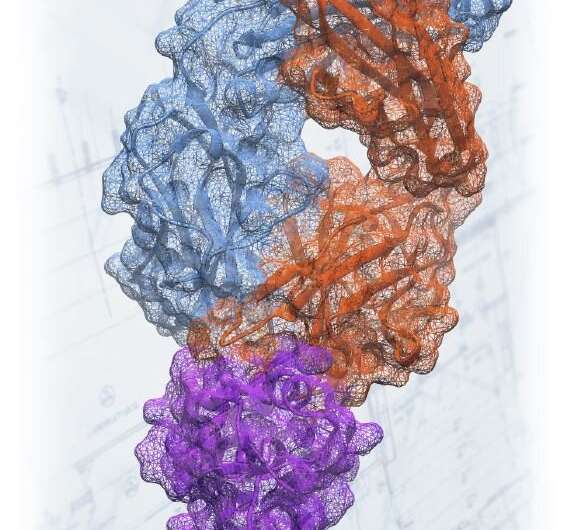Making structural changes to antibody has potential for reducing cancer tumours

Guided by "blueprints" produced at the Canadian Light Source (CLS) at the University of Saskatchewan, a group of scientists from academia and industry made structural changes to an antibody that is now showing a lot of potential for reducing cancer tumours.
"I feel very excited in terms of the potential for this antibody to move forward towards clinical development," said Dr. Jean-Philippe Julien from the Hospital for Sick Children Research Institute and the University of Toronto (U of T). "We've tested it in one pre-clinical cancer model and saw encouraging tumour inhibition."
Julien said the overarching goal of the research, carried out with colleagues from a number of U of T laboratories and biotech Northern Biologics, was to advance the development of cancer therapeutics that use antibodies, and in this case, using them on one particular signaling pathway—the Wnt/Frizzled pathway—that links molecules on the surface of cells to molecules in their interior.
The surface molecules sense what is happening in the body around them and then translate or communicate to the cell's interior, he explained. That signal guides what the cell will do, for example grow or differentiate itself into a new kind of cell.
"Wnt signalling is a natural pathway that is very prevalent in the body and is very important for cell development," he said, "but with cancer, that pathway is hijacked and overactivated. That's one of the reasons why cancer cells grow so quickly. Our goal is to find a drug that will slow or stop the cancer growth."
Previous research identified three antibodies "that looked good for slowing the cancer's growth" but when they were tested in mice, they were found not to be well tolerated or were very short lived, said Julien. "That made them unsuitable candidates to move forward towards the clinic. They needed to be fixed."
At the CLS, X-ray diffraction and crystallography allowed the researchers to create detailed images or blueprints of the antibodies to better understand how they were interacting with pieces of the signaling pathway, "and once we found out what was going wrong, we were successful in fixing one of the three."
The "fixing" Julien referred to involved altering the composition of the antibody slightly. "One example is if it is binding too tightly, that can lead to toxicity so we reduced its capacity to bind. We were looking for that sweet spot between the drug candidate being well tolerated and tumour inhibition, playing with all kinds of parameters in the pre-clinical environment."
He added that his research would not have been possible without the high-resolution images he was able to produce at the CLS.
The fine-tuned antibody worked at inhibiting tumor growth when tested in a pancreatic cancer model "but there is a lot of evidence that the Wnt/Frizzled pathway is involved in many different cancers and we're anxious to see how good our molecule is against those."
The partners involved in this work will conduct further tests of the antibody and will advance it to the next stage of trials.
"Our work shows how using facilities like the CLS contributes to these types of discoveries," said Julien.
More information: Swetha Raman et al. Structure-guided design fine-tunes pharmacokinetics, tolerability, and antitumor profile of multispecific frizzled antibodies, Proceedings of the National Academy of Sciences (2019). DOI: 10.1073/pnas.1817246116
Journal information: Proceedings of the National Academy of Sciences
Provided by Canadian Light Source

















